
* The first Canberra prototype took to the air in 1949. The type would then remain in service with the UK for the rest of the century, with over 900 built in Britain by four manufacturers in a series of variants. Many Canberras would be modified into new variants during their service lives, or be adapted to special test and trials fits.

* The English Electric (EE) company was formally established in 1918, with the firm initially focused on the production of electrical gear for railroads and trams, but later diversifying into a number of product lines, including weapons and aircraft. During World War II, EE "second sourced" Handley-Page Hampden and Halifax bombers for the British Royal Air Force (RAF), with the company setting up a design team in 1944 to handle Halifax modifications.
The company then second-sourced production of the de Havilland Vampire jet fighter; armed with experience in aircraft manufacturing and engineering, EE officials decided to work on their own aircraft. To head the company's design office, in July 1944 EE hired on William Edward Willoughby "Teddy" Petter, who had been technical director of the Westland aircraft company, where he had led the design of aircraft including the Lysander, Whirlwind, and Welkin. From 1943, the British Air Ministry had considered a jet-powered follow-on to the de Havilland Mosquito fast bomber, and Petter had been tinkering with the concept before he hired on with EE.
In early 1945, the Ministry of Supply (MoS), acting on behalf of the Air Ministry, issued specification "B.3/45" for a two-seat high-speed medium bomber with a radar blind bombing system. The B.3/45 specification had drifted a bit from the original concept of a "Jet Mosquito", with the new aircraft to be focused on high-altitude bombing, not low-altitude attack as had been the Mosquito's particular specialty. High-altitude flight meant powerful engines, and the only turbojet potentially available that could do the job was the Rolls-Royce "Axial Jet 65 (AJ.65)", then in development. The AJ.65 would later become the "Avon", and would be the powerplant of many British combat jets of the 1950s.
Petter considered a number of designs for the B.3/45 bomber, including some featuring swept wings, but finally came up with a configuration involving mid-mounted straight wings, with an AJ.65 engine mounted in a nacelle in the middle of each wing. The configuration was along the general lines of that of the Gloster Meteor, Britain's first jet fighter, though the bomber was by no means a "scaled-up Meteor" -- the most that could be said was that the Meteor was clearly influential, being a straightforward design that was known to work. EE submitted a brochure on the proposed design to the MoS in September 1945, and in January 1946 the company was awarded a contract to move on to full development and manufacture four prototypes of the "E.A1" or "A.1", as it was known at the outset. The prototypes are also referred to in some sources by the designation of "Bomber Mark 1" or "B.1", but this usage seems to have been informal.
The initial prototype of the A.1, with tailcode VN799 and painted a neat turquoise overall, was rolled on 29 April 1949, this machine being fitted with twin Avon RA.2 engines, providing 26.7 kN (2,720 kgp / 6,000 lbf) thrust each. Initial flight was on 13 May 1949, with company test pilot Roland P. "Bee" Beamont at the controls. Further trials went well, and the initial prototype "Canberra", as the type had been named in the meantime, put on displays at the Farnborough Air Show in September, where it "wowed the crowds" with Beamont's low-level maneuvers.
The second prototype, tailcode VN813, performed its first flight on 9 November 1949. It was painted in "official" RAF Bomber Command colors, black on the bottom and light gray on top; the following prototypes would also have this color scheme. VN813 was distinct from the other prototypes in that it was powered by twin Rolls-Royce Nene turbojets, providing 22.3 kN (2,270 kgp / 5,000 lbf) thrust each. The Nene was a centrifugal-flow engine and required visibly larger nacelles; the future of combat jet propulsion seemed to clearly lie with axial-flow engines like the Avon by that time, but there were worries that the Avon development program might go off track, and so VN813 was fitted with Nenes as insurance. Avon development proved successful, and so VN813 ended up being the only Nene-powered Canberra. This aircraft would go into service as a testbed after trials, finally being scrapped in 1959.
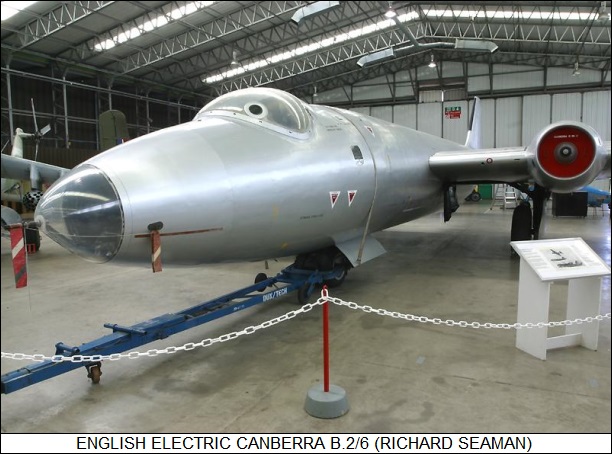
The third prototype, VN828, retaining the Avon RA.2 engines, performed its initial flight on 22 November 1949. It was much along the lines of the first prototype, except that the first prototype had a dorsal fin fillet and the third did not. It also went to operate as a trials machine through the 1950s, as discussed later.
The fourth prototype, VN850, performed its first flight on 20 December 1949. It resembled the first prototype in powerplants and configuration, though it had a number of significant internal changes. During the next summer, it performed trials of wingtip tanks, each with a capacity of 1,135 liters (300 US gallons / 250 Imperial gallons). It later went to Rolls-Royce for use as an engine testbed. It had the unfortunate distinction of being the first Canberra to be lost in a crash, suffering an engine fire on landing approach on 13 June 1951, the accident killing Rolls-Royce test pilot R.B. Leach.
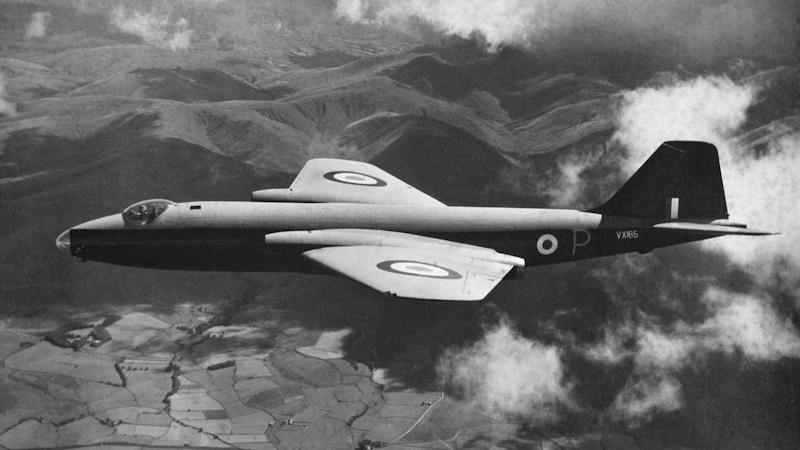
The Canberra had seemed so promising that the MoS had, on 1 March 1949, already awarded EE a contract for an initial batch of Canberras, including "Bomber Mark 2 (B.2)" machines, "Photo-Reconnaissance Mark 3 (PR.3)", and "Trainer Mark 4 (T.4)" machines. The first of two B.2 prototypes included in the contract performed its initial flight on 23 April 1950, with the first deliveries to an operational RAF squadron in May 1951. The PR.3 and T.4 followed the B.2 into RAF service.
BACK_TO_TOP* The Canberra B.2 makes a good baseline for description of the family. The B.2 was of all metal construction, built in five modular subassemblies: front fuselage, center fuselage, rear fuselage, and the two wings. As mentioned, the Canberra was of generally conventional configuration, with a mid-mounted straight wings, each wing interrupted by a nacelle with an Avon engine, and a conventional tailplane assembly. The machine had tricycle landing gear, with the twin-wheeled nose gear retracting backward and the single-wheeled main gear hinged in the wings to retract inward towards the fuselage. The gear was hydraulically actuated; ground steering was by differential braking of the mainwheels, with the nosewheel free-castoring. There was a bumper under the tail to protect the aircraft from ground scrapes on take-off.
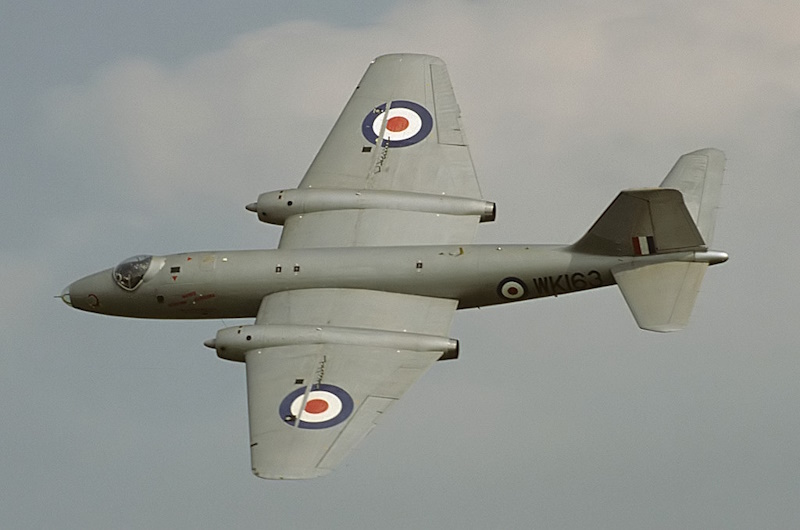
The wings were built around a single spar and featured wedge-shaped outer panels with a slight dihedral. Flight controls were conventional, with ailerons outboard and four-section flaps inboard. There were pop-up finger-type airbrakes on the top and bottom of the wing, just outboard of the engine. The tailfin was swept, with a one-piece rudder; the B.2 featured a tailfin "squared off" near the top, though the initial prototype had a rounded tailfin early on. The tailplanes were fixed, with conventional elevators and a steeper dihedral. There were trim tabs on the rudder and ailerons. None of the flight surfaces were power-boosted.
___________________________________________________________________
ENGLISH ELECTRIC CANBERRA B.2:
___________________________________________________________________
wingspan:
19.5 meters (63 feet 11 inches)
wing area:
89.23 sq_meters (960 sq_feet)
length:
19.96 meters (65 feet 6 inches)
height:
4.75 meters (15 feet 7 inches)
empty weight:
10,070 kilograms (22,200 pounds)
max loaded weight:
20,860 kilograms (46,000 pounds)
maximum speed:
915 KPH (570 MPH / 495 KT)
service ceiling:
14,630 meters (48,000 feet)
range (no tanks):
4,275 kilometers (2,656 MI / 2,310 NMI)
___________________________________________________________________
The Canberra B.2 was powered by twin Avon 101 / RA.3 turbojets providing 28.9 kN (2,950 kgp / 6,500 lbf) thrust each. The Avons were started by pyrotechnic cartridges: pictures of Canberras starting up their engines are always marked by streams of ugly black smoke pouring out of the front of the nacelles. If the aircrew were sloppy about procedures, they could end up with a cockpit full of smoke; and there are stories of onlookers jumping to the conclusion that the engines had caught fire, and so taking a hose to them. It appears that cleaner-burning cartridges were eventually developed. Although the design had provision for fuel tanks in the wings, in the B.2 all internal fuel storage was in the fuselage. The 1,135-liter wingtip tanks could be fitted, as well as a bomb bay ferry tank.
The B.2 carried no fixed armament. It could haul up to 2,720 kilograms (6,000 pounds) of stores in its bomb bay, a typical warload being six 450-kilogram (1,000-pound) bombs. There were no underwing stores pylons.
The B.2 carried a crew of three in a pressurized cockpit; there was no air-conditioning. The pilot sat forward under a "goldfish bowl" style canopy, with a metal "collar" on the back of the "bowl" that the A.1 prototypes had lacked. The navigator and bombardier -- or "bomb-aimer", as the RAF had it -- sat side-by-side in a rear "coal hole" compartment, with a small window on each side towards the top of the fuselage, and a single small window on the left side of the fuselage, to provide some light and view. All three crew sat on Martin-Baker Mark 1 series ejection seats, and got into and out of the aircraft through a hatch on the right side of the nose. Avionics were simple, including radios; identification friend or foe (IFF) transponder; an "Orange Putter" tail warning radar; and navigation aids, including a "Gee-H" precision radio bombing system. There was no autopilot, which would prove something of an obnoxious omission.
The B.2 featured a glazed nose, with the bombardier crawling forward to target the bombload using an optical bombsight while lying prone. There was a pitot tube mounted on the front of the nose glazing. As mentioned, the original plan had been to fit a sophisticated radar bombing system to the Canberra, with all four prototypes built with a solid nose and provision for two crew. The development of the radar bombing system ran into trouble, and that meant falling back to the optical bombsight and adding a bombardier.
* Aircrews found the Canberra a pleasant aircraft to fly, though its lack of power-boosted controls and autopilot could make it a bit tiresome for the pilot. The Canberra's performance was so impressive that no first-generation jet fighter -- such as the Meteor, Vampire, or US Lockheed F-80 Shooting Star -- was either fast enough or could fly high enough to catch it, though the later introduction of second-generation jet fighters such as the Hunter and F-86 Sabre eliminated this advantage. The Canberra set a number of speed-distance records early on -- most significantly, a two-way crossing of the Atlantic on 26 August 1952, with the single B.5 (discussed later) piloted by Beamont making the trip from the UK to Newfoundland and back in 10 hours 3 minutes 30 seconds.
The Canberra was also very maneuverable, and it could operate from relatively short airstrips. Its "low to the ground" configuration improved serviceability since stands weren't required, though apparently the machine did have a few quirks that ground crews didn't care for -- for example, fitting the wingtip tanks was said to be a pain. The aircraft's poor climate conditioning was a drawback, the fishbowl canopy turning the cockpit into a hotbox in the sunlight, while the crew in the coal hole tended to freeze in flight operations. The coal hole was also not for the claustrophobic.
A total of 422 Canberra B.2s -- including the two prototypes and a handful sold on the export market (discussed later) -- was built into 1955, with the type becoming the primary bomber asset of the RAF. The onset of the Korean War in 1950 had led to something of a panic to re-arm, and so the machine was manufactured by a total of four British aviation firms: 212 Canberras were built by EE, 75 by Avro, 75 by Handley-Page, and 60 by Short Brothers. These were the only Canberras built by Avro and Handley-Page; Shorts, in contrast, would remain a Canberra builder to the last.
* The PR.3 reconnaissance variant featured a forward fuselage stretch of 36 centimeters (14 inches), giving a length of 20.33 meters (66 feet 8 inches) instead of 19.97 meters (65 feet 6 inches). The longer fuselage permitted installation of a reconnaissance payload, with one vertical and six oblique film cameras. There was a bay for flares behind the camera pack, and fuel tanks were installed where the bomb bay had been on the B.2, giving the machine a range of 5,770 kilometers (3,585 miles) on internal fuel. The crew was reduced to two, and a photo sight was installed in place of the bombsight; the nose glazing was retained but lacked an "optically flat" panel. A total of 36 PR.3s was built, all by EE, including one prototype.
Although details remain classified and unclear, in 1953 and 1954 a few PR.3s and B.2s, modified to carry a powerful US-built "F22" telescopic camera in the bomb bay, were sent on high-altitude reconnaissance sorties against Eastern Bloc nations, including a famous overflight of the Russian missile-test center at Kapustin Yar in August 1953. Soviet interceptors were unable to reach the operating altitude of the Canberras, and none of the intruders were shot down -- though the Canberra that did the Kapustin Yar overflight came back full of holes from heavy anti-aircraft artillery. Border flights of Canberras with the F22 camera continued into 1955 under a program codenamed ROBIN.
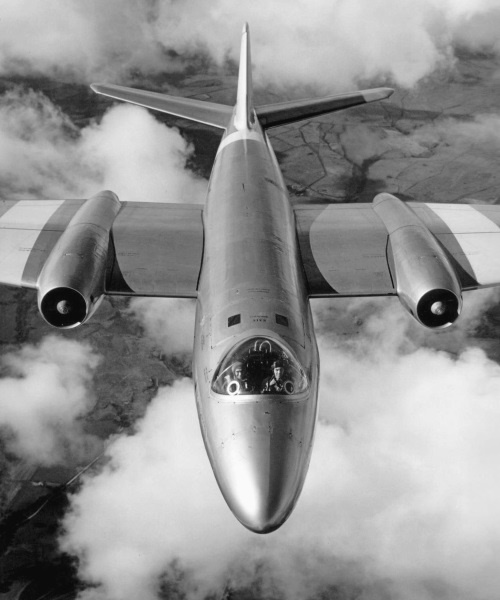
The T.4 trainer was effectively a B.2 with a solid nose, dual controls, and two seats crammed, somewhat uncomfortably, under the fishbowl canopy. The navigator position in the "coal hole" was retained. Ironically, the accident rate of the B.2 was relatively low, due to the type's good handling, but shot up after the introduction of the T.4. The problem turned out to be procedural issues, and the flight instructors were educated in how to tell trainees how to fly the aircraft right. 79 T.4s were built new, including one prototype and some export subvariants, all by EE. There were also a number of conversions from B.2 to T.4 spec for both UK service and the export market.
BACK_TO_TOP* Although the B.2 was highly satisfactory, the Canberra design still had plenty of room for growth. Two PR.3 prototypes had actually been ordered, but one was actually completed by EE as a "target marking" bomber, the "Canberra B.5", intended to drop flares or incendiaries on a target for plastering by following bomber formations. It retained the stretched fuselage of the PR.3 but added "wet" wings, with a fuel tank in each wing forward of the spar. It was otherwise kitted out like the B.2, featuring a bombsight and nose glazing with a flat optical panel. It also ended up being fitted with a Dunlop antiskid braking system and, very importantly, uprated Avon 109 / RA.7 turbojets, providing a maximum thrust of 33.5 kN (3,410 kgp / 7,500 lbf) each.
The target-marking mission was more or less obsolete by that time and the B.5 didn't enter production, but it acted as the effective prototype of the "Canberra B.6", with the longer fuselage, wet wing, antiskid brakes, and Avon 109 engines. With the uprated engines, internal bombload was increased to 4,500 kilograms (10,000 pounds). The first B.6 performed its initial flight on 11 August 1953, with the type going into RAF service in 1954. 55 were built by EE and 49 built by Shorts, including export subvariants, for a total of 104.
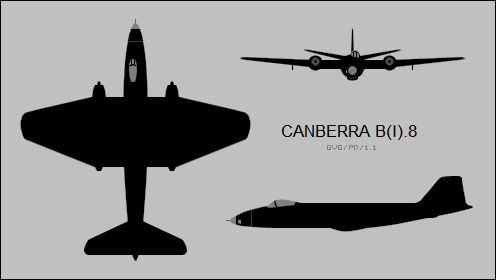
An improved reconnaissance variant, the "Canberra PR.7", was built in parallel with the B.6, featuring the wet wing, antiskid brakes, and Avon 109 engines. A total of 82 was built, including export subvariants, all by EE.
* Although the Canberra had been explicitly designed for a high-altitude bomber requirement, the RAF still needed a low-level attack capability, and the Canberra's excellent low-level handling meant it seemed suited to the job. As a result, the B.6 was modified for the attack or "intruder" role as the "B(I).6".
One of the requirements for the low-level attack job was cannon armament, and so a special cannon pack that could be plugged into the rear of the bomb bay was designed by Boulton-Paul. The pack contained four Hispano 20-millimeter cannon with 525 rounds per gun. The bomb bay doors were modified to permit fit of the pack, while leaving the front of the bomb bay free for carriage of bombs. The pack could be removed to permit a full load of bombs in the bomb bay. A stores pylon was fitted outboard on each wing, with each pylon capable of carrying a 450-kilogram (1,000-pound) bomb or a 37-round pack of 5-centimeter (2-inch) SNEB / Brandt unguided rockets. A gunsight was fitted in the cockpit for the pilot.
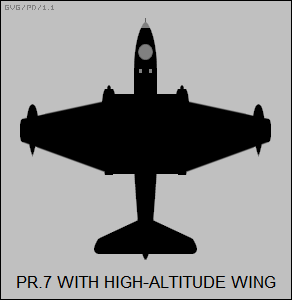
Initial flight of the B(I).6 was on 31 March 1955. B(I).6s were originally delivered in natural metal; however, since they were low-level operations machines, they were generally repainted in frontline service in a gray-green disruptive camouflage pattern. Only 24 B(I).6 machines were built, all by EE; it was strictly an interim type, while work went ahead on the more optimal "B(I).8" attack variant.
* The one-off B.5 machine was modified to act as the prototype for the B(I).8, and performed its first flight in its new configuration on 23 July 1954, sporting a sinister all-black color scheme. The B(I).8 featured the cannon pack, modified bomb bay, and stores pylons fitted to the B(I).6, but it also had a completely redesigned forward fuselage section. The original Canberra "fishbowl" canopy was perfectly adequate for high-altitude operations -- but for low-level operations, the lack of optically-flat surfaces was a problem for aiming and dodging obstacles.
The new front fuselage featured accommodations for two crew. The pilot sat under a fighter-type clamshell canopy, hinged in the rear; the canopy was offset to the left, the offset canopy being one of the intriguing "Briticisms" of aircraft design of the era. The navigator sat in a "coal hole" forward and to the right. The crew got in and out through a hatch on the right side of the nose, roughly as before. The pilot sat on a Martin-Baker Mark 2 series ejection seat, but the navigator had to get out by jettisoning the crew hatch, with a hydraulically-actuated windbreak popping out to make escape easier. Although the B(I).8 retained a glazed bombardier's nose, there was no bombsight -- all bomb-aiming was by the pilot through an optical gunsight.
A total of 157 B(I).8s was built by EE, with 7 built by Shorts, for a total of 164 machines. This sum includes various export subvariants, some of which had such luxuries as an autopilot. Two B.2s were also converted to a "B.8" standard by Boulton-Paul, being fitted with the B.8 forward fuselage but no armament updates. These two aircraft were used as trials machines, mostly by Ferranti for airborne radar development.
BACK_TO_TOP* The Canberra's operational ceiling of 15,250 meters (50,000 feet) was outstanding for its era, and as the type was entering service thought was being given to developing a Canberra that no adversary interceptor would be able to reach. There were two keys to higher ceiling: the new Avon RA.24 engine, which could provide 50.1 kN (5,110 kgp / 15,200 lbf) thrust, 50% more than the Avon 109 / RA.7; and a redesigned wing. Early concepts envisioned dramatically increasing the span, but that didn't work out structurally and aerodynamically; a new wing was designed with extended chord inboard of the engines and a span stretch of 1.15 meters (3 feet 10 inches).
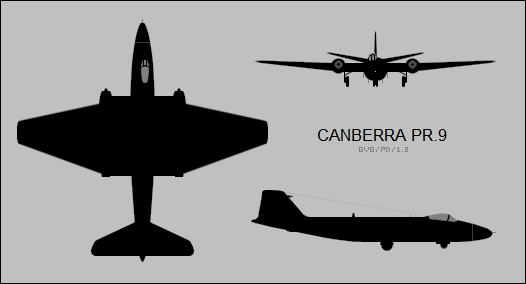
A PR.7, WH793, was modified with the new engines and wings by Napiers, with the initial flight of this demonstrator on 8 July 1955, with Napier test pilot Mike Randrup at the controls. Climb rate was massively improved, but improvement in ceiling was modest, since the increased-chord wing was "draggy". Beamont managed to almost make 18,300 meters (60,000 feet) on 18 September 1956, but barely had enough fuel to get back home after doing it.
That was disappointing, but the benefits of the configuration were substantial enough to approve production of a high-altitude PR Canberra, the "HA PR.9". It featured a new forward fuselage, with an offset canopy like that of the B(I).8, but no nose glazing except a port under the nose for a forward-looking camera. There were two crew, in separate pressurized compartments, the pilot getting into his cockpit by climbing in with a ladder and the navigator getting into his compartment through the nose, which hinged open to the right. Both sat on upward-firing Martin-Baker ejection seats, with the navigator punching out through a panel on top of the nose. The wingtip fuel tanks could still be carried, but the attachment didn't move out with the wingtip extensions, and so they were fitted slightly inboard from the wingtips. The PR.9 was the only production Canberra to have full power-boosted flight controls.
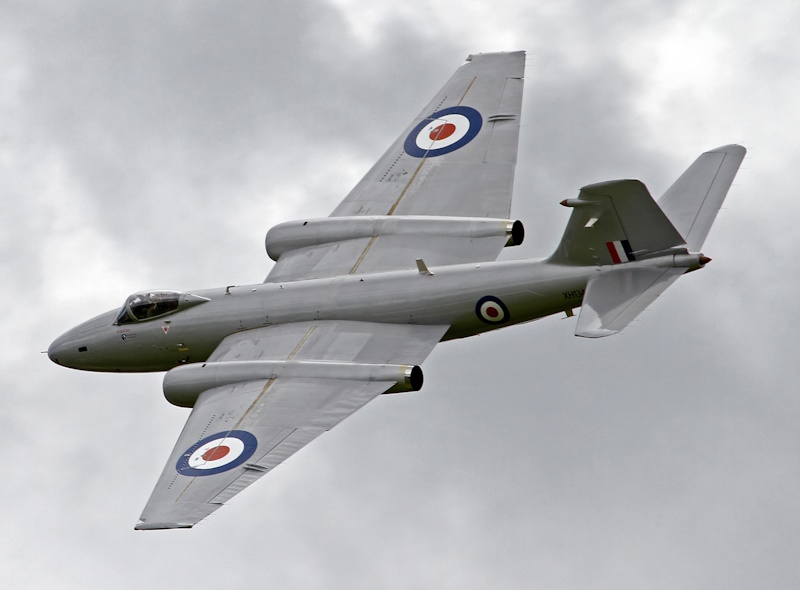
A total of 23 PR.9s was built; the contract was issued to EE, but the company farmed out the exercise to Shorts. The first production PR.9 performed its initial flight on 27 July 1958, though this machine was lost in a flight accident over Liverpool Bay a few months later, the navigator being killed. One of the PR.9s was retained by Shorts and used in various trials; it was given the designation of "SC.9". One of its more interesting applications was the evaluation of the seeker system for the Skyflash air-to-air missile (AAM), an improved British-built derivative of the American AIM-7 Sparrow AAM.
* The 23 PR.9s were the last new-build Canberras produced in the UK, for a total British production of 939 machines, including prototypes and export machines. 139 were built by Shorts, 75 by Avro, 75 by Handley-Page, and 650 by EE.
As an interesting footnote, in parallel with PR.9 development, EE performed a study on a Canberra night / all-weather interceptor, releasing a document describing the "P.12" in March 1956. It was effectively a B(I).8 with Avon RA.24 engines, as per the PR.9; an AI.18 radar system in a nose radome; and a Vickers Red Dean radar-guided AAM slung under each (modified) wingtip. The document claimed a prototype could be available by November 1958, but nobody bit on the proposal. Incidentally, the Red Dean AAM never reached production, though it was test-launched by Canberras in trials.
BACK_TO_TOP* By 1955, 37 RAF squadrons were flying the Canberra, including 30 bomber squadrons and 7 reconnaissance squadrons. Canberras operated out of Britain, West Germany, Malta, and Cyprus, with temporary deployments as far afield as Australia. Due to the lack of cockpit air conditioning, Canberras operating in tropic conditions tended to be "hotboxes", sometimes getting so hot on the runway as to be painful to touch. Cockpit sunscreens were implemented for the ground crews, and blower units were often used to keep the temperature under control, but there were never enough blower units to go around.
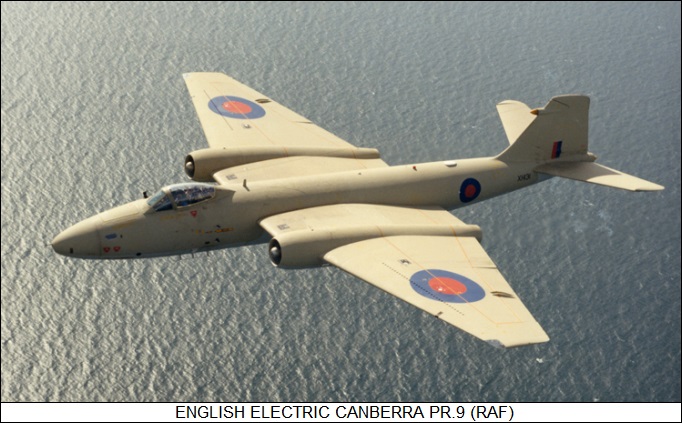
Even at this early date, the Canberra was in combat. The British had been fighting a growing Communist insurgency in Malaya since 1948. Early on, air support for counterinsurgency forces had been provided by World War II veterans like the Mosquito and Spitfire, but as the RAF obtained improved aircraft, there was every good reason to see how they would perform in a shooting war. By early 1955, Canberras had arrived to join the fight; due to a pinch on transport, each Canberra carried a ground crew NCO along with the normal three crew; since the aircraft was cramped normally, the flight with four bodies on board must have been uncomfortable.
In any case, small groups of Canberras began to plaster insurgent jungle camps, each aircraft carrying six 450-kilogram (1,000-pound) bombs. Different Canberra bomber squadrons were rotated through the war until the emergency was declared over in 1960. Ironically, PR Canberras were not sent to the theatre until that year, reconnaissance support for the Canberra bomber squadrons having been supplied by Gloster Meteor PR.10s.
Even after the end of the Malaya emergency, Canberras maintained a Far Eastern presence. In 1964, Indonesia began to make threatening noises against Malaysia, and so the Canberras were put on a war footing again. It never came to active shooting, fortunately, and after two years of standoff and confrontation diplomacy finally ended the dispute. PR Canberras continued to fly missions in the Far East from Hong Kong and Singapore until they were finally retired.
* In the meantime, in 1956 Canberras had flown strikes in Operation MUSKETEER, the Anglo-French-Israeli assault on Egypt touched off when Egyptian President Gamel Nasser abruptly nationalized the Suez Canal. The Canberras operated out of Malta and Cyprus.
There was no Gee-H radio targeting system set up with coverage over Egypt, and so 25 B.6s were modified with the "Blue Shadow" side-looking radar system (SLAR), with Boulton-Paul doing the installation. The Blue Shadow featured an antenna in a strip fairing along each lower side of the aircraft, just forward of the wings; scans were printed out on heat-sensitive paper. The Blue Shadow machines were designated "B.6(BS)" and marked targets for other strike aircraft using flares. To prevent confusion and "friendly fire" incidents, many of the Canberras and other aircraft were painted with a pattern of three yellow stripes alternating with two black stripes, around the rear fuselage and outer wings; some aircraft had white stripes due to a shortage of yellow paint. They were known as "invasion stripes", because the scheme had been used by Allied aircraft during the Normandy landings in 1944.
On 31 October 1956, 38 Canberras performed night attacks on a number of Egyptian airfields. Post-strike assessment showed they inflicted much less damage than desired, so on 1 November 21 separate raids were conducted in daylight, with much more satisfactory results and no losses. More strikes were conducted up through 5 November; in the meantime, the US had reacted angrily to MUSKETEER and exerted intense pressure on the British to cease and desist. They did so, with a cease-fire on 6 November and a withdrawal of the joint force soon after.
MUSKETEER had significant impact. It has been seen in hindsight as marking the final end of the British Empire, and led to a retrenchment that would have painful effects on the British aviation industry. Many promising advanced aircraft development programs were canceled, with the result that the Canberra ended up staying in service well longer than anyone would have expected. MUSKETEER had the contrary effect of bolstering the Anglo-American alliance, with the US taking action to mend fences and soothe British feelings. The French, irritated at the way the British had caved in to the Americans and broken ranks with the "three musketeers", promptly began diplomatic efforts that would lead to the creation of the European Common Market.
Only one Canberra was lost in combat during the operation, with a PR.7 on a covert spy mission chewed up by a Syrian Mikoyan MiG-15 fighter on 8 November, ironically after the cease-fire. The machine crash-landed in Lebanon, the navigator being killed but the other two aircrew surviving. One B.6(BS) was shot up during the fighting but made it back to base, where it was hastily patched up pending flight back to the UK for further work; it was, however, then lost in a crash in Cyprus along with its crew on 6 November.
* In 1961, Marshall of Cambridge began an upgrade program for B.6s, giving them a low-level attack capability by fitting them with wing pylons, though they didn't get cannon packs as with the B(I).6. These modified machines also got a fairly extensive systems refit, with new radios and a whizzy Decca rolling-map display, plus a film camera in the nose and in the leading edge of the right wing. Standard B.6s were given the new designation of "B.15" after this conversion, while Blue Shadow-equipped B.6(BS) machines acquired the designation of "B.16". There were 39 B.15 conversions and 19 B.16 conversions, with the upgrade program complete by 1963. The primary underwing store was a 72-round pack of 5-centimeter (2-inch) Microcell unguided rockets.
In 1965, a number of Canberra bombers were modified to carry the French Nord / Aerospatiale AS.30 radio-guided air-to-surface missile (ASM). This required modifications to the wing pylons and fit of the missile control system. These machines were not given any special designations. In the 1970s, eight of the B.15s were fitted with new electronics gear and redesignated "E.15". They were used in what was vaguely and suspiciously described as "special electronic and calibration duties".
* In 1968, the British, German, and Italian governments began development of a sophisticated new variable-geometry ("swing wing") strike, tactical reconnaissance, and interceptor aircraft, known originally as the "Multi-Role Combat Aircraft (MRCA)" and emerging eventually as the Panavia "Tornado". The word "eventually" is significant, since the development program was protracted and the Canberra had to soldier on, leading to jokers claiming that "MRCA" stood for "Must Refurbish Canberra Again". The first production Tornado finally flew in 1979, with most RAF squadrons replacing their Canberras with Tornados in the early 1980s.
That was by no means the end of the Canberra in RAF service, however. As discussed later, it was still in use in special applications, and the high-altitude PR.9 was seen as a valuable asset. It was continually updated with improved cameras and other sensors, as well as better countermeasures -- including a radar warning receiver (RWR) scavenged from other retired RAF aircraft, with a distinctive dartlike antenna fairing installed in the leading edge of the tailfin.
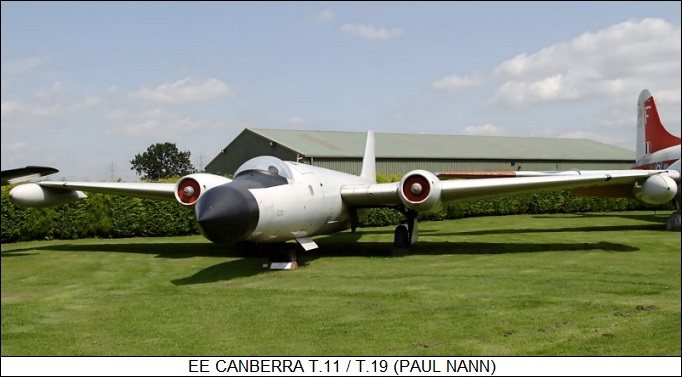
The PR.9 lingered in service in small numbers with the RAF into the 21st century. These aircraft were fitted with an improved US-built electro-optic long-range oblique imaging sensor package, apparently based on the SENIOR YEAR system developed for the US Lockheed U-2 spyplane. RAF PR.9s saw action in the Afghanistan intervention in 2002:2003. They were formally withdrawn from service on 22 June 2006, after 55 years of Canberra service with the RAF.
* The following list consolidates UK production of the Canberra, not counting foreign construction. Note that, as discussed later, UK-built Canberras for foreign users often had designations specific to the particular buyer, for example an export PR.7 might be designated "PR.57", with possibly some minor changes in kit; these alternate designations are ignored here. In any case:
Total UK production of the Canberra was 939 aircraft, with 650 built by EE, 139 built by Shorts, 75 by HP, and 75 by Avro.
BACK_TO_TOP* The Canberra was a sturdy, capable aircraft that was convenient to operate and relatively easy to modify, so it was not too surprising that there were many Canberra modifications. In 1955, Shorts received a contract to convert what would end up being 18 B.2s to a radio-controlled target drone configuration, designated the "U.10", featuring scoring systems and a self-destruct charge. Development was somewhat protracted, with the first U.10 supplied to the end user, the Weapons Research Establishment (WRE) in Woomera, Australia, in 1959. The WRE received 17 U.10s into 1962, the other one having been a prototype.
The Royal Navy's Fleet Air Arm (FAA) also awarded Shorts a contract for a similar target drone, the "U.14", differing mainly in the fit of power-boosted flight controls. Seven conversions were performed, one being a prototype; the six production machines were delivered in 1961, being used for weapons trials out of Malta. A few years later, the decision was made to reserve the "U" code for "utility" aircraft, and the U.10 and U.14 became the "D.10" and "D.14" respectively. Many of the drones were of course lost in trials, but a few survivors were converted back to B.2s for the export market.
* Beginning in 1970, a total of 24 B.2s was converted to the "TT.18" target tug configuration. They were fitted with twin "Rushton" winch / tow target units, one under each wing pylon; this item had been developed by Flight Refueling LTD (FRL) at the company's facility at Tarrant Rushton in the UK. The winch pod had a spinner on the nose to drive the winch mechanism, with the tow target snugged up into the bottom rear of the pod after being hauled in and secured.
The TT.18s could also handle sleeve targets, with the targets simply towed into the air dragging on the runway and then released before landing for recovery. The sleeve targets were only hauled a few hundred meters behind the tug, which aircrews found a bit unnerving; the Rushton targets could be reeled out several kilometers behind the aircraft, giving over-enthusiastic pilots less of a chance of engaging the tug by mistake.
14 of the TT.18s went to the RAF, 9 of them to the FAA, and one was retained by FRL for various trials. Apparently most of the trials performed by this last machine didn't have anything to do with the aircraft's target tug capability, but in 1976 it was used to tow a special radar-reflecting target under contract to the UK Civil Aviation Authority (CAA) to calibrate airport radars. The last TT.18s were retired in the late 1980s.
BACK_TO_TOP* In 1956, Boulton-Paul began a series of at least eight conversions of B.2s to the "T.11" radar trainer configuration, which was fitted with the AI.17 radar for the Gloster Javelin all-weather / night fighter in a spikelike nose radome. The T.11s gave up this role in 1961, but they were not retired; the AI.17 radars were removed, with the aircraft then being redesignated "T.19". They were apparently used in exercises to help train surface-to-air missile (SAM) batteries, essentially as piloted targets to acquire and track, though of course they were not fired on. They were finally retired in the 1980s.
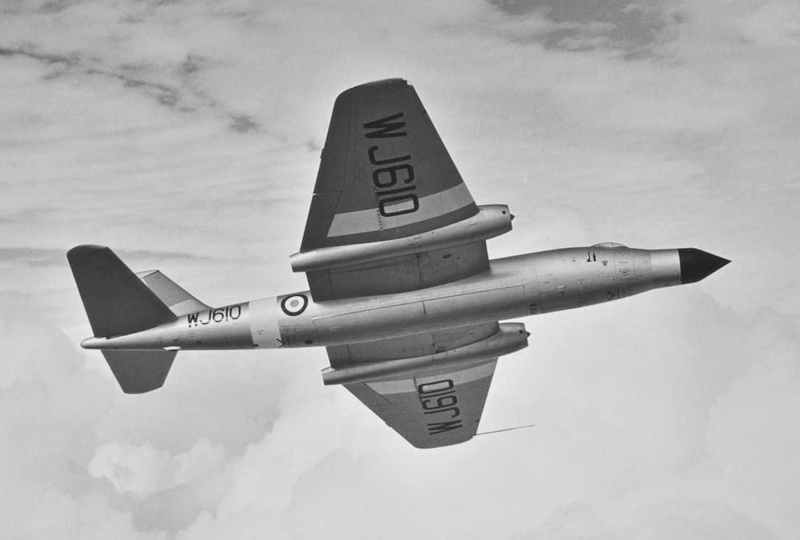
* In 1973, the FAA awarded a contract to BAC for conversion of what would end up being a total of seven PR.7s to "T.22" radar trainer configuration, these machines being fitted with an extended "pointy nose" to house the "Blue Parrot" radar fitted to the Royal Navy's Blackburn Buccaneer strike aircraft. After retirement of the Buccaneer from FAA service in the late 1970s, they soldiered on in the electronic warfare / electronic countermeasures (EW / ECM) training role, being finally retired in the mid-1980s.
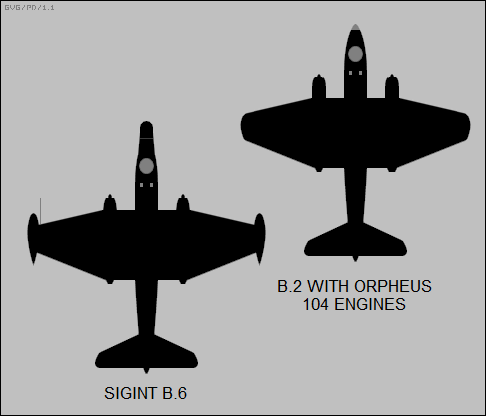
* In 1963, a number of Canberra B.2s and B.6s were improvisationally fitted with EW / ECM gear for use in the training role. The next year, the decision was made to obtain a more dedicated Canberra platform for a combined RAF / Royal Navy EW / ECM training squadron, leading to the award of a contract to British Aircraft Corporation (BAC, which had swallowed up EE in 1960) to convert 24 B.2s to "T.17" standard.
The initial flight of the first T.17 was on 3 September 1965. The conversion involved major modifications, resulting in one of the most cluttered Canberra variants ever flown. The T.17 had a bulbous nose with four small fairings around the sides, and was littered with antennas, vents, and fairings. The combined training unit, Number 360 Squadron, received its first T.17 in December 1966.
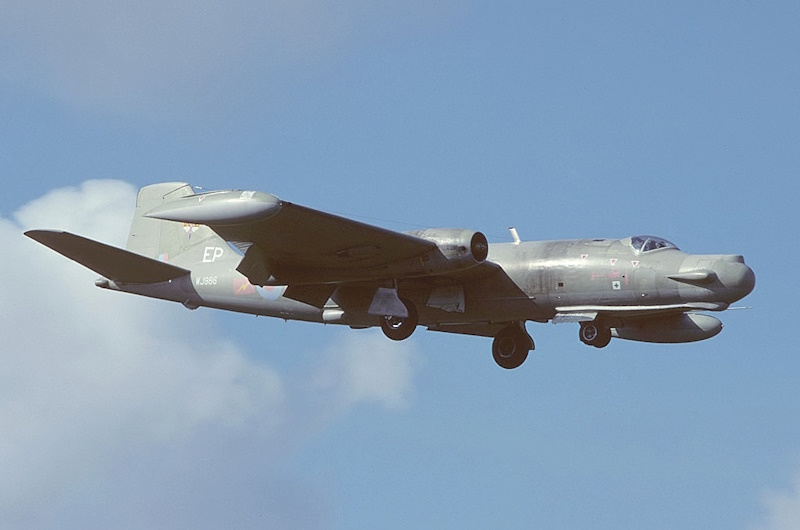
The T.17s were used in training exercises to make complete nuisances of themselves, jamming radars and communications to ensure that the training was realistic. It must have been tremendous fun on the giving end; not so much on the receiving end. They were upgraded continuously with improved gear, one interesting item being wingtip tanks modified as chaff dispensers. In 1985 through 1987, six were given a fairly significant upgrade of navigation and jamming gear, and were redesignated "T.17A". The T.17s and T.17As were finally retired in 1994; at that time, one of the squadron's Canberras had been flying with the RAF for 43 years.
BACK_TO_TOP* Along with the Canberra variants produced by conversions, there were also a good number of one-off / small batch modifications for special missions or trials. Attempting to come up with a complete list of these "specials" would be painful, but it is possible to discuss a number of the more interesting special modifications.
During the mid-1950s, a number of RAF B.2s and B.6s were used in support of British nuclear weapon tests in the Pacific. These machines featured wingtip tanks adapted to act as fallout-collection devices, and were modified with other gear to support the mission; they carried a radiological systems specialist as part of the crew.
There were also a number of conversions of B.2s and B.6s to specialized signals intelligence (SIGINT) configurations for the RAF. Early conversions had a T.11 style "pointy nose", which led some sources to claim they had radar in the nose. In reality, it contained a SIGINT direction finder system, the T.11 nose simply having been available hardware. These machines could be distinguished from a T.11 by the presence of Blue Shadow SLAR antennas alongside the forward fuselage. Later machines featured a rounded nose fairing.
Other details of the SIGINT machines remain scarce. It is known that they carried a high-capacity data tape recorder in the bomb bay to store intelligence data obtained during sorties, and they were also equipped with the Green Satin doppler navigation radar, but the aircraft and their missions were very secret and little information about them was ever released. Late in its career, one of these machines was fitted with an infrared sensor turret behind the cockpit, it seems as part of a program to classify the infrared signatures of Soviet aircraft.
* The British aviation industry made extensive use of Canberra for trials. In the early 1950s, a B.2 was fitted with Armstrong-Siddeley Sapphire Mark 3 turbojets, providing 32.1 kN (3,275 kgp / 7,220 lbf) thrust each, being later updated to Mark 6 engines with 376.9 kN (3,765 kgp / 7,200 lbf) and finally Mark 7s, with 45.9 kN (4,680 kgp / 10,300 lbf). This machine was lost in a flight accident on 10 November 1954, with both engines failing and the aircraft being written-off after a troublesome dead-stick landing, though the crew survived. Two more B.2s were then fitted with Sapphire 7s for trials, with a third fitted with afterburning versions of the same engine.
The Sapphire was never used on production British Canberras, but as discussed later, the Americans used it on their license-built B-57 Canberra in place of the Avons. In the late 1950s, one of the B.2s used in the Sapphire tests was used for trials of the Viper small turbojet, which was fitted to a special underwing pylon.
One particularly interesting engine test Canberra was a B.2 used to evaluate the powerful Bristol Olympus turbojet. During initial trials in 1952, the B.2 was fitted with Olympus 99 engines, capable of almost 44.5 kN (4,535 kgp / 10,000 lbf) but derated for the time being to 35.6 kN (3,630 kgp / 8,000 kgp). Even with derated engines, it was a lot peppier than a normal B.2, and set a world altitude record of 19,406 meters (63,668 feet) in 1953. Both engines flamed out and the pilot, Wing Commander Wally Gibb, had to shut off systems and glide slowly down to lower altitude to relight.
In 1954, this aircraft was fitted with twin Olympus 101s, each providing 48.9 kN (4,990 kgp / 11,000 lbf) thrust. It was used to set a new altitude record in 1955, exceeding the old one by over 600 meters (2,000 feet). It suffered an engine failure on takeoff on 12 March 1956, and crashed into a grove of oak trees, the crew coming out generally unhurt, but the B.2 written off. It was replaced in 1957 with another B.2, fitted with Olympus 104 engines providing 58 kN (5,910 kgp / 13,000 lbf) thrust each. This machine remained in service until 1959, when it was retired and eventually scrapped.
Rolls-Royce of course used the Canberra for Avon trials. As mentioned, the fourth A.1 prototype was used for Avon RA.2 tests until it was lost in a crash in 1951. The second production B.2 was used by Rolls-Royce to test RA.3, RA.7, RA.14, RA.26, and finally RA.29 Avons, the last providing 46.8 kN (4,770 kgp / 10,500 lbf) thrust each. Two other B.2s were used to evaluate non-afterburning Avons, while a fourth was used to test afterburning Avons -- first the RA.7R, then the RA.14R, and finally the RA.24R used on the English Electric Lightning interceptor, with 50.1 kN (5,110 kgp / 11,250 lbf) dry thrust and 64.4 kN (6,560 kgp / 14,430 lbf) afterburning thrust each. This machine was likely the most powerful Canberra ever flown.
De Havilland used a B.2 to evaluate the Gyron Junior turbojet, this machine originally flying with one Gyron Junior and one Avon, then being fitted with two Gyron Juniors. De Havilland also use the unique Nene-powered A.1 prototype to evaluate the Spectre liquid-fueled booster rocket, installed behind the bomb bay. Napier similarly used a B.2 and a B.6 to test the liquid-fueled Double Scorpion rocket, with the B.2 scoring a world altitude record of 21,430 meters (70,310 feet) on 28 August 1957. The B.6 was lost when the rocket motor blew up at 17,100 meters (56,000 feet) on 9 April 1956, with the crew surviving ejection at a record altitude; it was an honor they might have passed up had they been asked. Rocket-boosted Canberras were considered for the job of high-altitude radiation sampling after nuclear tests, but it didn't happen.
* In 1955, two B.2s were fitted up with hose-drogue tanker units and probes to perform tests of inflight refueling gear for FRL. The trials went well, but oddly the RAF never thought to fit any Canberras for inflight refueling. They were certainly never used as tankers in service. A PR.3 with a long nose probe and other unusual kit was used by the Royal Aircraft Establishment's (RAE) Meteorological Research Flight.
Other trials use of the Canberra included tests of AAMs, radar, miscellaneous avionics, and ejection seats. Bee Beamont performed three trial flights of a B.2 with the canopy removed and his face masked to see how effective the cockpit wind deflector shield was; although Beamont was a resolute test pilot, even he had to concede that after the last flight, which reached a top speed of 842 KPH (523 MPH), he'd had as much as he could take.
BACK_TO_TOP